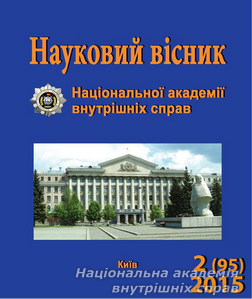Procedural forms of interaction of investigators from other law enforcement agencies during the investigation of violent crimes committed against minors
Keywords:
interaction, the investigator, law enforcement, operational units, a violent crime
Abstract
Considered the problem questions connected with the peculiarities of the interaction of investigators with the staff of operational units and the criminal police for children’s Affairs, and the competent authorities and officials of foreign States during the investigation of violent crimes committed against minors. In the context of the investigation of violent crimes committed against minors, the problem of the interaction of investigators and other law enforcement officials is quite versatile, and related legal, organizational, tactical and psychological issues are equally pertinent to all stakeholders, especially in modern conditions, when one of priority directions of activity of the state is to ensure protection of the rights and interests of children in accordance with normative legal acts of Ukraine and international treaties. In order to ensure effective communication at all stages of the investigation of violent crimes committed against minors, it is necessary to know its legal framework and organizational forms, take into account the existing forensic recommendations, to respond to the psychological characteristics of situations. So, we are talking about an integrated approach to the solution of this problem in a practical, scientific and educational-methodical aspects. In our opinion, considering the problem of interaction in the investigation of violent crimes against minors, such an approach is necessary to guide the development of tactical and methodical recommendations concerning the interaction of the investigator with the staff of other law enforcement agencies. The implementation of the investigator’s procedural forms of cooperation in the investigation of violent crimes committed against minors, should be based only on the provisions of the Criminal procedure of Ukraine. The effectiveness of the procedural forms of interaction between the investigator and law enforcement officials depends on the specialization of investigators and employees of operating units, actively engaging in the investigation of the staff of criminal militia for children, avoiding formalism as by investigators in the provision of instructions, and the employees of operational units in their implementation, as well as the creation of a single legal space for effective cooperation between law enforcement authorities of different States.Downloads
Download data is not yet available.
Abstract views: 72 PDF Downloads: 763
How to Cite
[1]
Paskowski, V. 1. Procedural forms of interaction of investigators from other law enforcement agencies during the investigation of violent crimes committed against minors. Scientific Herald of the National Academy of Internal Affairs. 95, 2 (1), 186-194.
Issue
Section
Law enforcement activities
- Authors reserve the right to authorship of their own work and transfer to the magazine the right of the first publication of this work under the terms of the Creative Commons Attribution License, which allows other persons to freely distribute published work with mandatory reference to authors of the original work and the first publication of an article in this magazine.
- Authors have the right to enter into separate additional agreements on non-exclusive dissemination of the work in the form in which it was published in the journal (for example, to post an article in the institution's repository or to publish as part of a monograph), provided that the link to the first publication of the work in this journal is maintained.
- The journal's policy allows and encourages the posting of articles by authors on the Internet (for example, in electronic storehouses of institutions or on personal websites), both before the submission of this manuscript to the editorial office and during its editorial processing, as this contributes to the creation of a productive scientific discussion and positively affects the efficiency and dynamics of citing the published work.




